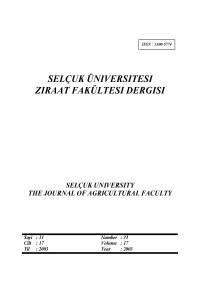Azospirillum Brasilense ve İki Rhizobium Türünün Bazı Yaygın Fasulye (Phaseolus Vulgaris L.) Çeşitlerinde Nodulasyona Etkisi
Abstract
Bu çalışmanın amacı, Azospirillum ve Rhizobium ikili aşılamasının fasulyenin nodülasyonundaki sinerjistik etkisi-nin fasulye çeşitlerinden bağımsız olup olmadığını test etmektir. İki faktör (Azospirillum brasilense Sp7 ve Rhizobium yoğunlukları) içeren, genelleştirilmiş tesadüf blokları (fasulye çeşitleri) deneme desenine göre düzenlenmiş 3 tekrarlı bir saksı denemesi kurulmuştur
Rhizobium (Rhizobium etli ve Rhizobium tropici karışımı) inokulasyonu, 106 kob (koloni oluşturan birim) ml-1 sevi-yesinde, tüm nodülasyon verilerini (kök sisteminin ilk 5 cm’lik kısmında, ilk 5 cm’lik kısmın dışında kalan bölgedeki ve toplam nodül sayısı ve ağırlığı) artırmıştır (p< 0.05). Ancak, Rhizobium seviyesinin daha fazla artırılması, kökün ilk 5 cm’lik kısmındaki nodül sayısı hariç nodülasyon verilerinde LSD testine göre fark yaratmamıştır (p<0.05). LSD testle-rine göre, nodülasyon açısından en iyi çeşit şekerdir (p<0.05). Azospirillum nodül ağırlığını artırmıştır (p<0.05).
Muhtemelen rizosferdeki inokule edilen bakteri yoğunluğu başlangıç inokulum yoğunluğundan bağımsız olarak zamanla belirli bir dengeye ulaşmaktadır. Bitki destekleyebileceği kadar nodül oluşumuna izin vermektedir. Dolayısıy-la, Rhizobium ve Azospirillum içeren inokulumdaki Rhizobium yoğunluğunun belirli bir seviyenin üzerine çıkarılması-nın nodülasyon açısından bir anlamı yoktur. Azospirillum’un sadece nodül ağırlığını artırmış olması, bu bakterinin bitki gelişmesini artırarak dolaylı yoldan nodülasyonu etkilediğini göstermektedir.
The Effects of Azospirillum Brasilense and Two Rhizobium Species on The Nodulation of Bean (Phaseolus Vulgaris L.) Cultivars
Abstract
The objective of this study is to determine whether the synergistic effect of Azospirillum and Rhizobium double in-oculation on nodulation in common bean is additive with respect to bean cultivar. A pot experiment, designed as a generalized randomized block (bean cultivars) with 2 factors (Azospirillum brasilense Sp7 density and Rhizobium density) and 3 replications, was conducted.
Rhizobium (a mixture of Rhizobium etli and Rhizobium tropici) inoculation at 106 cfu ml-1 increased all nodulation values (nodule number and dry weight in the first 5 cm of root system, the root system excluding the first 5 cm and total root) at 5 % significance level. However, increasing the Rhizobium density further did not change the nodulation pa-rameters except for the nodule number in the top 5 cm of root system at the 5 % significance level as per the LSD test. Azospirillum increased nodule weights (p<0.05). Based on the LSD tests, the best cultivar in terms of nodulation was şeker (p<0.05).
The population of inoculated microbes probably reached an equilibrium level by time regardless of the initial cell density in inoculants. The plants supported only a limited number of nodules. Therefore, increasing the Rhizobium cell density in inoculant above certain levels is not suggested in terms of nodulation. The results of this study indicated that Azospirillum could provide the nodules with more carbon to function by affecting the plant growth.
Details
| Primary Language | English |
|---|---|
| Subjects | Soil Sciences and Ecology |
| Journal Section | Research Article |
| Authors | |
| Publication Date | June 25, 2003 |
| Submission Date | January 1, 2003 |
| Published in Issue | Year 2003 Volume: 17 Issue: 31 |
Selcuk Agricultural and Food Sciences is licensed under a Creative Commons Attribution-NonCommercial 4.0 International License (CC BY NC).


